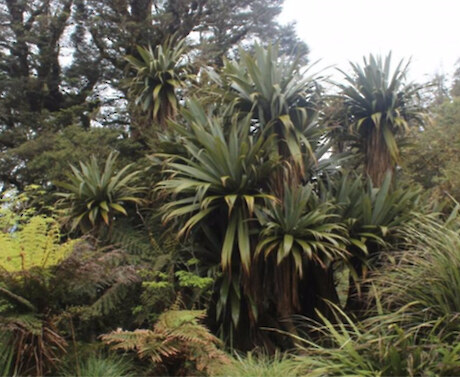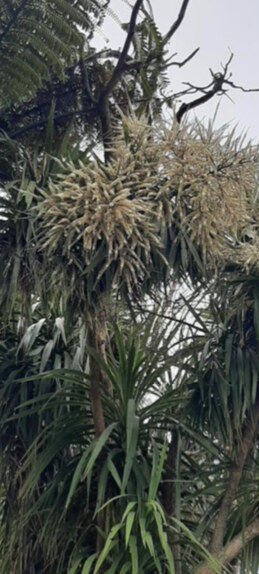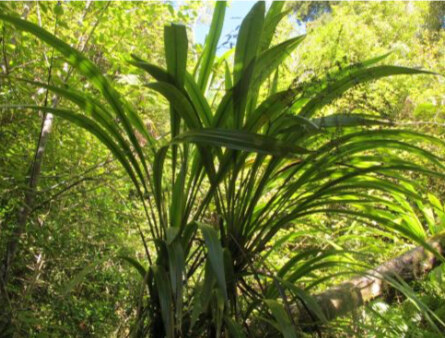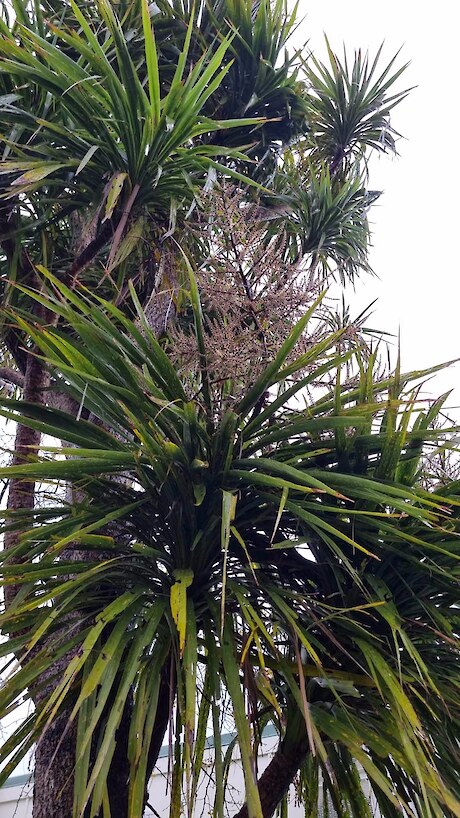Cordyline species
Download info sheetIdentification & Cultivation: There are about 24 species of Cordyline species, indigenous to South-East Asia and across the western Pacific islands. They are monocotyledons, belonging to the Asparagaceae family sub. Lomandroideae—though it is considered by some, as belonging to the Agavaceae (Yucca) clan. Five species are endemic to NZ. Ti kouka (Cordyline australis, Cabbage Tree), titoi (Cordyline banksii/diffusa), tī koraha or tī rauriki (C. pumilo dwarf cabbage tree, pygmy cabbage tree), Tōī (Cordyline indivisa), mountain cabbage tree aka Dracaena indivisa, Dracaenopsis indivisa, Cordyline hookeri, Cordyline hectori), Ti, Norfolk Island cabbage tree (Cordyline obtecta), Three Kings cabbage tree, from Norfolk Island and Northern NZ).
Early Māori both wildcrafted and propagated Tī kōuka and used them as an important source of food, as well as fibre and medicine. The inner blanched leaves and heart from its stems have a cabbage- like flavour when eaten.
The Greek word kordyle, meaning ‘club’, is the origin of the name Cordyline, referring to its enlarged underground rhizomes.
Tī kōuka grows all over the country, but prefer wet, open areas like swamps. It has attractive sprays of scented white flowers, loved by bees, which develop into berries, which are loved by birds; they are a key means of propagation.
Sadly, there is a pathogen, Phytoplasma australiense, which causes a disease, called ‘Sudden Decline’, affecting C. australis. Fortunately, C. banksii appears to have more resistance to it. Tōī (Cordyline indivisa); Joe Dillon, from WHB
Tōī (Cordyline indivisa); Joe Dillon, from WHB Ti kōuka in flower, Egmont Village, Jan Smith
Ti kōuka in flower, Egmont Village, Jan Smith
Tōī (Cordyline indivisa): From ‘Welly’s Hungry Botanist’ (WHB aka Joe Dillon): “Tōī (Cordyline indivisa) is sure to be one of our most attractive native plants. To me it looks more like something you’d see in a Dr Seuss book than in real life, yet over the last few months I’ve seen it pretty regularly. Tōī is a montane relative of the more well-known tī kouka (Cordyline australis), typically being found close to the treeline, in alpine scrub, or in clearings in subalpine forest throughout Aotearoa. In cold Fiordland, this species also exists close to sea level, as it does near Kāwhia, where cold, humid karst gullies provide a lowland refugia. Tōī is a truly unusual species in the Cordyline genus which is otherwise tropical, with representatives throughout the Pacific Ocean and South East Asia. Tōī can be easily identified by its huge bluish leaves, which have been used in weaving, like many other Cordyline species.”
Parts used: Leaves, stem, root, seeds. The sap from the leaves, the soft part of the inner leaves, the inner ‘bulb’ of the leaves eaten as a vegetable, hence the name cabbage. For stomach pains, diarrhoea & irregularity of the bowels, children’s colic, thrush, blood purifier; topically for cracked skin, sores and cuts.
Constituents: Fructans and fructo-oligosaccharides, which can be found within the leaves, stems and roots. The leaves also contain saponins and tannins. The seeds are rich in fatty acids and linoleic acid.
Therapeutic actions: The young leaves close to the stem are mainly used, and have astringent, antimicrobial, antidiarrhoeal and wound healing properties.
Medicinal uses: Nutritive, vulnerary; it can assist with healing sores, cuts and wounds. For diarrhoea, the astringency reduces fluid and electrolyte loss, and the antimicrobial properties can undoubtedly be useful. Colic and stomachache can also be alleviated by the leaves, or young stems. Fluid from cooking inner shoots and the top of the stem was traditionally trunk drunk by nursing mothers.
Dosage: The fibrous leaves are rubbed for some time to extract the inner sap and a mucilaginous gel, this then this is applied to cuts, sores and inflammatory skin conditions.
For internal use, 2-3 fleshy leaves close to the stem should be cut into pieces then decocted for at least 20 minutes, then the liquid drunk, one to three times daily. Considered good for treating diarrhoea and dysentery. Ti kouka, Cordyline australis (Cabbage tree) Recommended weekly dose; 10-30mls.
“Medicine belongs to those who need it” – Hohepa Kereopa
Culinary uses: The inner bulk of young leaves at the base of the leaf heads, and top of the stem, can be cut into segments like a leek and cooked for quite some time, then eaten as a vegetable. They have a sweet but mildly astringent taste, and are regarded as a healthy and cleansing tonic. The roots as well as stems are also edible and a source of starch and sugar. Extracting the cabbage-tree sugar or kauru was a serious and protracted process. Young trees, four to six feet high, were cut down close to the roots, the outer bark stripped away, and the sappy and fibrous heart (kauru stalks) sun-dried then cooked in an earth oven. Higher sugar content is found in the roots of young plants though, and these were dried then soaked in water and slowly steamed in an elaborate process in an earth oven.
 Cordyline banksii, Waitakere, Nile River, Charleston, West Coast-Melissa HutchisonOther Uses: The fibrous leaves of tī kōuka are used for weaving, and when dried or dropped from the tree make a great kindling. Fibrous branches also make a good torch or transporter of fire. The rich sugar content of Tī kōuka also made it a suitable plant to ferment an intoxicating alcoholic beverage from, and this was undertaken by some early European settlers.
Cordyline banksii, Waitakere, Nile River, Charleston, West Coast-Melissa HutchisonOther Uses: The fibrous leaves of tī kōuka are used for weaving, and when dried or dropped from the tree make a great kindling. Fibrous branches also make a good torch or transporter of fire. The rich sugar content of Tī kōuka also made it a suitable plant to ferment an intoxicating alcoholic beverage from, and this was undertaken by some early European settlers.
History & Mystery: These species have a long and consistent tradition of uses; for survival, medicinal and spiritual uses. Ti kouka was traditionally planted as a trail and boundary marker, around urupā (cemeteries), and to commemorate births; due to its longevity. The leaves were and can be used for a wide range of items including; rain capes, baskets, ropes, sails, and sandals.
References: Phil Rasmussen; https://en.wikipedia.org/wiki/Cordyline; Joe Dillon, WHB; Treasures of Tane, Rob Tipa.
Prepared for the Herb Federation of New Zealand’s Herb Awareness Month 2024 by Karina Hilterman & Phil Rasmussen. Enquiries: www.herbs.org.nz
Advisory Note: This text is given as a general guidance. If any adverse reactions occur or symptoms persist, please contact a qualified medical herbalist or medical doctor immediately.

